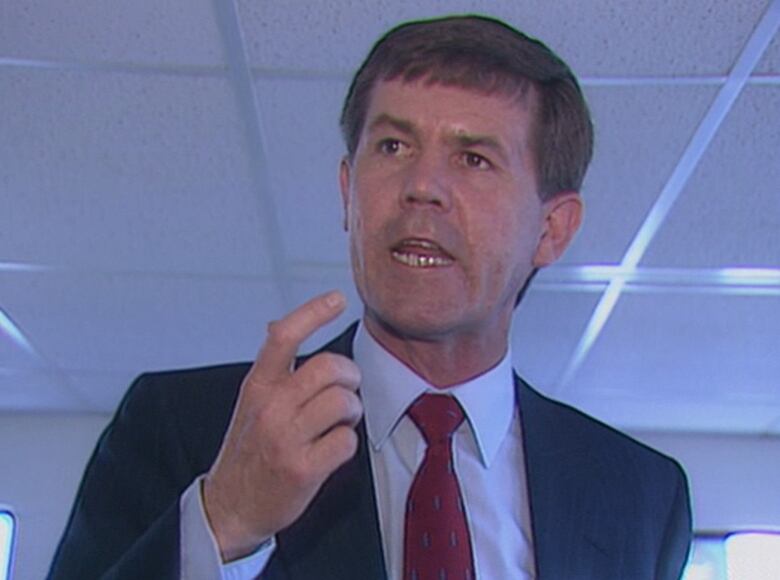How a governing party can be turfed even if it wins more votes
In 1989, the Tom Rideout Tories lost a series of close races by just dozens of votes

We've had a succession of polls this week that appear to contradict each other or do they? We had an MQO poll that showed the Liberals with a lead that might seem comfy, but then we had an Abacus Data poll that showed the Tories with a lead. On Thursday, another poll showing basically a statistical tie.
So, it's a close race. But what will matter most is not the party that gets the most votes overall, but has the resources to get the vote out in neighbourhoods, small towns and districts, squeaking out wins by often narrow margins.
We've seen unexpected results that defy expectations before, of course. In the last U.S. presidential election, Hillary Clinton came through with the most votes as the national polls had predicted but lost because Donald Trump scored strategic victories in states that added up to a Republican win in the Electoral College.
In the current Newfoundland and Labrador campaign, we might be at a similar risk of projecting a trend from a poll onto our own electoral map of 40 very different districts.
I put this to you: a governing party can be thrown out of office, even if it gets more votes.

That's because it's happened before.
Let's revisit that tide-turningelection of 1989.
In a nutshell, that's the election where Tom Rideout's Tories got more votes than Clyde Wells's Liberals.
And yet the Liberals formed the government with 10 more seats than the Tories.
How did that happen?
Landslides in districts they were going to win anyway
In a nutshell, the Tories won huge in districts they were going to win anyway. Rideout, for instance, had the biggest majority that year, with 3,230 votes more than his top challenger.
A landslide in a safe seat is a pretty quiet landslide.
The Liberals won one dogfight after another, squeaking out narrow victories in districts across the province.

In fact, no less than nine Liberals won their seats in April 1989 with majorities of fewer than 200 votes. They included future cabinet ministers Roger Grimes, Hubert Kitchen, Chuck Furey, Art Reid and Graham Flight.
(It went the other way, too. Wells himself famously lost a battle to win back his old seat of Humber East from PC incumbent Lynn Verge, with just 143 votes dividing them. As well, future Liberal premier Beaton Tulk lost his seat in Fogo by 94 votes, to Tory Sam Winsor.)
Still, the Tories thought they had the edge going into the campaign, and were comforted by polling results.
Rideout, fresh after winning a leadership race that pitted five PC cabinet ministers against each other, mistook the fervour he felt in the air for both party readiness for an election (it wasn't) and the public's enthusiasm for the change he was going to bring. Change was in the air, but many voters thought 17 straight years of PC rule was enough.
When the votes were counted, the Tories had 47.64 per cent of them.
The Liberals had just slightly less: 47.18 per cent.
But they had the votes where they mattered, and that's how they wound up with 31 seats to the PCs' 21.
On Thursday, that last point where the votes wind up will matter a great deal.

Are Thursdays really that weird for an election?
Nope, they're not.
When Dwight Ball pulled the plug and the writ dropped, there was a chatter that it would be odd to be voting on a Thursday.
Actually, this will be the sixth time that there's been an election in the post-Confederation period on a Thursday.
- Trail Mix: Get updates on the election delivered to your inbox
- Keep up with the campaign: Click here for all of our N.L. Votes coverage
The last time we voted on a Thursday was in 1996, when Brian Tobin was taking over the Liberal mantle from Clyde Wells. Between 1959 and 1971, three of the four elections in that period were held on a Thursday.
What's the most popular day of the week to vote? That would be Tuesday. We've gone to the polls on a Tuesday eight different times.
The oddball days? Hello, Wednesday and Friday, which had just one each (in 2015 and in 1972, respectively.)
Here's the full list:
- Monday, May 27, 1949
- Monday, Nov. 26, 1951
- Tuesday, Oct. 2, 1956
- Thursday, Aug. 20, 1959.
- Monday, Nov. 19, 1962.
- Thursday, Sept. 8, 1966
- Thursday, Oct. 28, 1971
- Friday, March 24, 1972
- Tuesday, Sept. 16, 1975
- Monday, June 18, 1979
- Tuesday, April 20, 1982
- Tuesday, April 2, 1985
- Thursday, April 20, 1989
- Monday, May 3, 1993
- Thursday, Feb. 22, 1996
- Tuesday, Feb. 9, 1999
- Tuesday, Oct. 21, 2003
- Tuesday, Oct. 9, 2007
- Tuesday, Oct. 11, 2011
- Wednesday, Nov. 30, 2015
- Thursday, May 16, 2019
How many of those do you remember?
Perhaps Thursday's vote will be one for the ages.












_(720p).jpg)


 OFFICIAL HD MUSIC VIDEO.jpg)
.jpg)



























































































